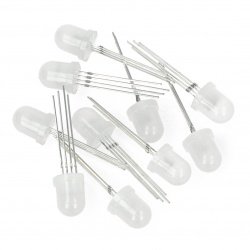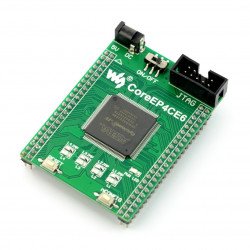Most of today’s electronic devices is controlled by various types of processors and microcontrollers. Almost unlimited possibilities of programming different kinds of behavior, high computational performance and low cost of currently available chips made them ideal choose for designers. However, conventional microcontrollers also have an important drawback: all of programmed instructions are executed in turn, so in single-core processors (like over 99% of microcontrollers) there is no way to run two or more functions exactly at the same time. This enforces doing some compromises between execution time and complexity at given clock frequency. Multicore processors can handle some tasks at the same time, but even this solution may be insufficient in really high-speed, complex operations like multi-channel signal processsing, real-time video processing or some artificial intelligence applications. In these fields of technology another great family of devices can be used. It’s FPGA (Field programmable gate arrays).
FPGA boards and kits
Altera Cyclone IV EP4CE6 - development board FPGA - Waveshare 6483
Development allow us to study the FPGA chips. The module is equipped with EP4CE6E22C8N with 80 I/O. The board is configured through the JTAG interface. It also has buttons,...USB programmer and debugger for Xilinx devices - Waveshare 6530
A platform that allows you to program and debug Xilinx devices via USB. The device is based on CY7C68013A+FPGA chip, which is compatible with original Xilinx platforms. It...Spartan-3E XC3S500E Xilinx - development board FPGA - Waveshare 6692
Development board allows us to study the FPGA chips. The module is equipped with XC3S500E with 116 I/O. The board is configured through the JTAG interface. It also has...See also
FPGA – what is it and how can I use it?
FPGA is a special type of logic (digital) integrated circuit that can be programmed to do some tasks by user-reconfigurable hardware structure. Of course, large manufacturers of electronics can afford designing and ordering specific-function ICs (called ASICs), that ideally fits their needs. However this solution is very expensive due to overhead of IC structure manufacturing process. Therefore, in many applications the use of FPGA is the best possible solution. The FPGA chip contains hundreds or thousands of logical blocks that can be freely interconnected to perform parallel, application-specific tasks as it would be executed by custom ASIC. The process of generating instructions on how to connect the logic blocks is called configuration. Most of FPGAs are reconfigurable, so the “program” (configuration) is stored in external memory mount on the same PCB as the FPGA and loaded to FPGA internal configuration controller during system startup (it is, after turning on power supply). The configuration files are written using specific sets of “instructions” and commands, named hardware description language (HDL). Currently there are two languages used in daily FPGA development practice: Verilog and VHDL.
FPGA and CPLD development boards
In our store you can find great evaluation boards for both FPGA and CPLD chips. CPLD are another kind of programmable logic integrated circuits – they are less complex, slower and much cheaper than FPGA, therefore in some applications the use of CPLD is a quite sufficient solution. One of the most affordable FPGA development boards is Sipeed Tang Nano. The module contains GW1N-1-LV chip with embedded SRAM and user Flash memories, phase-locked loop (PLL), oscillator and of course FPGA array with 1152 LUT (look-up tables) and 864 flip-flops. The board uses USB C connector for power supply and built-in JTAG interface. The more complex, although still cost-effective Mimas V2 Spartan 6 FPGA Development Board contains Xilinx Spartan XC6SLX9 FPGA with 9152 logic cells, 1430 configurable slices, 11440 flip-flops and 90 kb of distributed RAM memory. The user can benefit from on-board 16 MB Flash memory with SPI interface, integrated USB 2.0 interface, 8 LEDs, 6 buttons, 8 DIP switches and a bunch of GPIO connectors for easy integration with external hardware. It also contains built-in 3-digit 7-segment Led display as well as power supply circuitry and JTAG connector. If you are interested in CPLD development, also check Waveshare DVK600 motherboard for CPLD/FPGA daughter boards.
High-end evaluation boards for advanced FPGA development
If you are already familiar with FPGA programming and searching for high quality, complex evaluation module for development of sophisticated applications, you can choose Numato Opsis FPGA board. It is intended to use in video processing applications and thus contains 256 MB of built-in RAM DDR memory running at 1600 MHz, 4 HDMI ports (two inputs and two outputs), as well as two Display Port sockets (input and output), Gigabit Ethernet and microSD slot. The system can handle up to 1080p / 30 fps video streams and supports display resolution of up to 4096 x 2304 px.



















































































































































































































































































































































